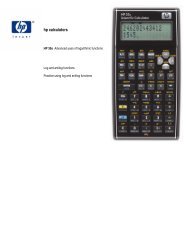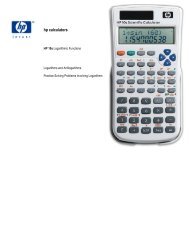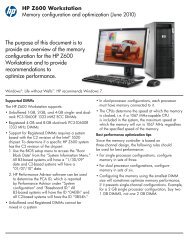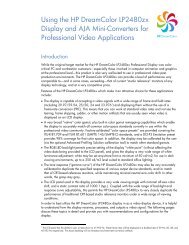Symbolic Differentiation
Symbolic Differentiation
Symbolic Differentiation
You also want an ePaper? Increase the reach of your titles
YUMPU automatically turns print PDFs into web optimized ePapers that Google loves.
hp calculators<br />
HP 50g <strong>Symbolic</strong> <strong>Differentiation</strong><br />
Methods used<br />
The differentiation commands<br />
Practice solving symbolic differentiation problems
hp calculators<br />
HP 50g <strong>Symbolic</strong> <strong>Differentiation</strong><br />
Methods used<br />
To perform symbolic differentiation we just use one of the differentiation commands. This is rather straightforward since the 50g builtin<br />
CAS can find symbolic derivatives of all built-in functions in any combination.<br />
The differentiation commands<br />
The HP50g provides three basic commands for differentiation which we can use for finding numeric values of derivatives. The<br />
simplest provided commands for differentiation are: DERIV, DERVX and ∂. The command ∂ is available from the keyboard by<br />
pressing the keys @¿. The other two commands are available in several menus. For example, to display the calculus menu,<br />
press !Ö.<br />
Its first menu item is 1.DERIV & INTEG.... and if ` is pressed, a menu which contains differentiation and integration commands is<br />
displayed.<br />
The menu items 2.DERIV and 3.DERVX are the other two basic differentiation commands. Any of these three commands can be<br />
used for symbolic differentiation. The commands DERIV and ∂ both take two arguments: The expression to be differentiated and the<br />
variable with respect to which we want to differentiate. DERVX is provided as a shorter way to perform differentiation when the<br />
variable of differentiation is the same with the CAS variable VX (usually X). The command DERIV will also accept a scalar<br />
expression and a vector of names, or even a vector of algebraic objects and a vector of names as arguments, allowing the user to<br />
find gradients or even hessian matrices. There are also other commands related to differentiation in this menu, like CURL, DIV, or<br />
HESS. The command CURL takes a three dimensional vector field and a three dimensional variables vector and returns the<br />
rotational of the field. The command DIV takes a vector field and a vector of variables and return the divergence of the field. The<br />
command HESS takes a multivariate function and a vector of variables and returns the hessian matrix, the gradient and the used<br />
vector of variables.<br />
Practice solving symbolic differentiation problems<br />
Example 1: Find the derivative of the function X 2 e -x<br />
hp calculators - 2 - HP 50g <strong>Symbolic</strong> <strong>Differentiation</strong><br />
Figure 1<br />
Figure 2<br />
Solution: @O@¿XXQ2*!¸X\`
hp calculators<br />
HP 50g <strong>Symbolic</strong> <strong>Differentiation</strong><br />
µ<br />
‚×2`<br />
hp calculators - 3 - HP 50g <strong>Symbolic</strong> <strong>Differentiation</strong><br />
Figure 3<br />
Figure 4<br />
Answer: Figure 5<br />
Example 2: Find the derivative of the function X 2 SIN(X)<br />
Solution: @O@¿XXQ2*SX`<br />
µ<br />
Figure 6<br />
Answer: Figure 7
hp calculators<br />
HP 50g <strong>Symbolic</strong> <strong>Differentiation</strong><br />
Example 3: Find the derivative of the function:<br />
Solution: @O@¿XXQ2+~yQ2/X*~y`<br />
˜@¿~y`<br />
µ‚×2`<br />
hp calculators - 4 - HP 50g <strong>Symbolic</strong> <strong>Differentiation</strong><br />
Figure 8<br />
Figure 9<br />
Answer: Figure 10<br />
Example 4: Find the gradient of the function x 2y – y 2x<br />
Solution: @OXQ2*~y-~yQ2*X`<br />
Figure 11<br />
Now input the vector of variables onto the stack. !Ô³X³~y`
hp calculators<br />
HP 50g <strong>Symbolic</strong> <strong>Differentiation</strong><br />
!Ö`2` (Note: this finds the gradient)<br />
‚×2`<br />
Figure 12<br />
Figure 13<br />
Answer: Figure 14<br />
Example 5: Differentiate the vector: for Z. Assume Algebraic mode.<br />
Solution: Create the vector: !Ô1/!Ü~y*~z…í<br />
1/!ÜX*~z…í1/!ÜX*~z`<br />
!Ö`2`!î…í~z<br />
`<br />
Figure 15<br />
Figure 16<br />
hp calculators - 5 - HP 50g <strong>Symbolic</strong> <strong>Differentiation</strong>
hp calculators<br />
HP 50g <strong>Symbolic</strong> <strong>Differentiation</strong><br />
‚×2`!î`<br />
Figure 17<br />
Answer: Figure 18<br />
hp calculators - 6 - HP 50g <strong>Symbolic</strong> <strong>Differentiation</strong>
















